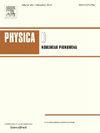Exploring the synergy of media awareness and quarantine classes in SiSAQEIHR model for pandemic control: A Deep LSTM-RNN predictions
IF 2.9
3区 数学
Q1 MATHEMATICS, APPLIED
引用次数: 0
Abstract
Media awareness and higher treatment rates are crucial in pandemics to prevent disease spread, but the synergy between quarantine and awareness is often neglected. This investigation explores the impact of media awareness on infectious diseases. For this purpose, a novel eight compartmental type mathematical model including eight individual classes, namely Immature Susceptible, Susceptible, Quarantine, Awareness, Exposed, Infective, Hospitality, and Recovered has been presented to depict disease dynamics. It incorporates a sigmoid type treatment rate, enhancing realism. This offers a fresh perspective on the study of infectious disease transmission. Mathematical analysis confirms the system’s positivity and boundedness, ensuring its theoretical stability analysis of the disease-free equilibrium point and applicability in predicting epidemic outcomes. Using the normalized forward sensitivity index, we have obtained sensitivity indices for factors associated with the basic reproduction number () and identified the essential parameters that significantly impact the modification in disease dynamics. Also, the influence of the parameters on is systematically analyzed and characterized through Global Sensitivity Analysis. Furthermore, this study underscores the importance of accurately predicting epidemic spread to enable timely interventions, focusing on the pivotal roles of Awareness, Hospitalization, and Exposed classes in dynamic epidemic model. A deep Long Short-Term Memory (LSTM) based Recurrent Neural Network (RNN) model is proposed for precise spread pattern prediction, leveraging advanced deep learning capabilities in time series analysis. Six hyperparameter topologies are analyzed to optimize prediction accuracy. Five statistical accuracy metrics reveal RMSE below 0.02 and and values exceeding 0.99 for all classes, validating satisfactory predictive performance. A real-life COVID-19 modeling study demonstrates the proposed LSTM-based model’s effectiveness in capturing complex dynamics, surpassing earlier traditional neural network methods. Furthermore, sensitivity analysis, varying the vaccinated proportion, confirms the robustness of the proposed model system in the realm of public health decision-making.
探索SiSAQEIHR模型中媒体意识和隔离类别的协同作用,用于大流行控制:深度LSTM-RNN预测
媒体意识和更高的治疗率对预防疾病传播至关重要,但隔离和意识之间的协同作用往往被忽视。本调查探讨媒体对传染病意识的影响。为此,提出了一种新的八区隔SiSAQEIHR型数学模型,包括八个个体类别,即未成熟易感、易感、隔离、意识、暴露、感染、接待和恢复,以描述疾病动态。它结合了s型治疗率,增强了真实感。这为传染病传播的研究提供了一个新的视角。数学分析证实了系统的正性和有界性,保证了系统对无病平衡点的理论稳定性分析和对疫情结果预测的适用性。利用归一化前向敏感性指数,我们得到了与基本繁殖数(R0)相关因素的敏感性指数,并确定了对疾病动力学变化有显著影响的基本参数。通过全局灵敏度分析,系统分析了各参数对R0的影响。此外,本研究强调了准确预测流行病传播对及时干预的重要性,重点关注了意识、住院和暴露类别在动态流行病模型中的关键作用。利用时间序列分析中先进的深度学习能力,提出了一种基于深度长短期记忆(LSTM)的递归神经网络(RNN)模型,用于精确的传播模式预测。分析了六种超参数拓扑结构以优化预测精度。五个统计准确度指标显示,所有类别的RMSE低于0.02,R和R2值超过0.99,验证了令人满意的预测性能。一项现实生活中的COVID-19建模研究表明,所提出的基于lstm的模型在捕获复杂动态方面的有效性优于早期的传统神经网络方法。此外,敏感性分析,改变疫苗接种比例,证实了所提出的模型系统在公共卫生决策领域的鲁棒性。
本文章由计算机程序翻译,如有差异,请以英文原文为准。
求助全文
约1分钟内获得全文
求助全文
来源期刊

Physica D: Nonlinear Phenomena
物理-物理:数学物理
CiteScore
7.30
自引率
7.50%
发文量
213
审稿时长
65 days
期刊介绍:
Physica D (Nonlinear Phenomena) publishes research and review articles reporting on experimental and theoretical works, techniques and ideas that advance the understanding of nonlinear phenomena. Topics encompass wave motion in physical, chemical and biological systems; physical or biological phenomena governed by nonlinear field equations, including hydrodynamics and turbulence; pattern formation and cooperative phenomena; instability, bifurcations, chaos, and space-time disorder; integrable/Hamiltonian systems; asymptotic analysis and, more generally, mathematical methods for nonlinear systems.
 求助内容:
求助内容: 应助结果提醒方式:
应助结果提醒方式:


